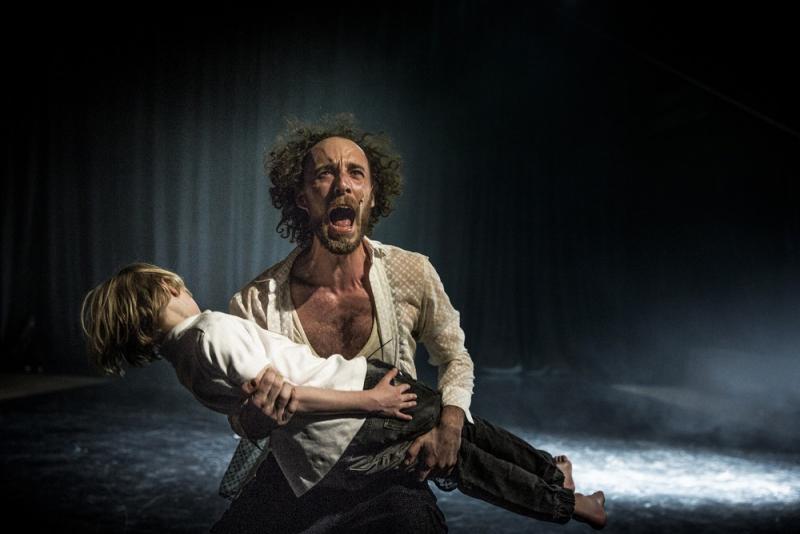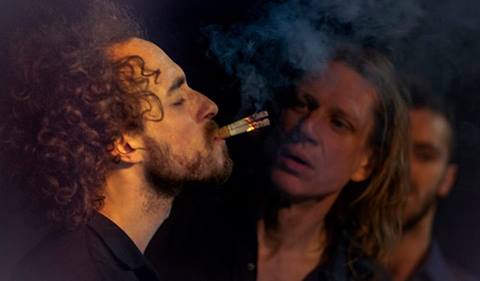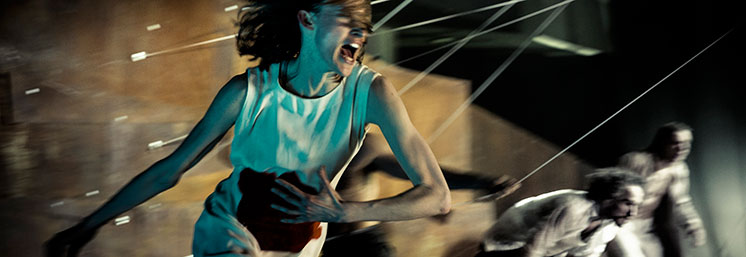Talk to the Demon, Brighton Dome | reviews, news & interviews
Talk to the Demon, Brighton Dome
Talk to the Demon, Brighton Dome
UK premiere from Belgian choreographer/director Wim Vandekeybus

One of the mottos made famous by internationally renowned chocolatier Willy Wonka was: “A little madness now and then is relished by the wisest men”. Perhaps it’s a quotation that Belgian choreographer Wim Vandekeybus, who put Talk to the Demon together, has framed on his wall.
The stage set features a row of rusted metal plates forming a wall on the left, and an odd Heath Robinson-esque wooden gadget on the right, with elastic lines reaching up from it to points in the ceiling. As the audience take their seats, a topless, paunchy man eyes them up, rolling around in an insectoid manner. From the start it's provocative, with the audience being asked to choose between two sweet-looking pre-teen children to play a lead role - Luke and Martha, their tee-shirts proclaim (De Bolle and Killick, respectively). We choose Luke but it turns out both children have equal time onstage and both are, incidentally, spookily deadpan and professional.
 The performance that follows is a series of vignettes, sometimes thematically connected in a way that’s comprehensible, sometimes not. The adult cast of four men and two women from Vandekeybus's Ultima Vez company are initially involved in a playground scenario, of fickle alliances and sudden, ruthless bullying, as in Dennis Potter’s Blue Remembered Hills. Vandekeybus has said he’s keen to move dance away from its reliance on music and this is a constant throughout. The troupe move as dancers, using their own percussive sounds and speech as rhythms, but also ostentatiously acting. In juvenile fashion they imitate each other, strip to their underwear, smoke cigarettes, throw stones noisily at the metal wall, but the childish scenario gradually moves from the comic to the ugly - manic laughter, howls, whipping and murder.
The performance that follows is a series of vignettes, sometimes thematically connected in a way that’s comprehensible, sometimes not. The adult cast of four men and two women from Vandekeybus's Ultima Vez company are initially involved in a playground scenario, of fickle alliances and sudden, ruthless bullying, as in Dennis Potter’s Blue Remembered Hills. Vandekeybus has said he’s keen to move dance away from its reliance on music and this is a constant throughout. The troupe move as dancers, using their own percussive sounds and speech as rhythms, but also ostentatiously acting. In juvenile fashion they imitate each other, strip to their underwear, smoke cigarettes, throw stones noisily at the metal wall, but the childish scenario gradually moves from the comic to the ugly - manic laughter, howls, whipping and murder.
One of Vandekeybus’s muses, who he has used in his films, is English actor Jerry Killick (father to Martha) and he has many speeches, telling the audience at one point that they chose “the wrong kid”. We chose “the shitty kid”. It’s taboo-breaking and funny, especially as Luke is there on stage, where he’s left for a brilliantly nightmarish sequence, one of the evening’s highlights, where one of the troupe, Elena Fokina, her hair over her face, becomes a monstrous slithering demonic mother figure, twitching about to a sinister, mesmerising, horror filmic soundtrack.
 There are many other highlights: Luke ordering the adults about so they become cows while he, a cowboy, rounds them up on one he has chosen to be his horse; Luke playing with the strange wooden object at the side of the stage, pinging it and plucking, creating amplified, electronically distorted sounds that the performers, all now attached to the roof by elastic, leap about to and interweave amongst each other; there’s a dementedly brilliant robot dance involving badmington rackets while Fokina rides around the stage on a tricycle, an abject figure akin to the grotesque puppet from the Saw films; and a battering, loud, explosive “war”, the stage a shadowplay of swirling light and movement.
There are many other highlights: Luke ordering the adults about so they become cows while he, a cowboy, rounds them up on one he has chosen to be his horse; Luke playing with the strange wooden object at the side of the stage, pinging it and plucking, creating amplified, electronically distorted sounds that the performers, all now attached to the roof by elastic, leap about to and interweave amongst each other; there’s a dementedly brilliant robot dance involving badmington rackets while Fokina rides around the stage on a tricycle, an abject figure akin to the grotesque puppet from the Saw films; and a battering, loud, explosive “war”, the stage a shadowplay of swirling light and movement.
There’s something of Antonin Artaud’s “theatre of cruelty” in it all, the way the audience is implicated, from a performer rushing across the front row to collect his own thrown underwear, to a clown questioning what we're thinking of him. It seems, somewhere within the visual overload, there's a question about the nature of human evil. Fortunately the extensive weirdness is often punctured by humour, dry one liners juxtaposed with the mayhem. Eventually however, it begins to pall and audience members start to leave.
Instead of saving the most animated sequences until last, the finale is slow and mournful; a death, an over-extended monologue about war (albeit accompanied by fascinating movement) and a lengthy, exceedingly slow conclusion involving clowns. The whole thing would have benefited from being at least 20 minutes shorter and, indeed, the programme indicated it had overrun by that amount. Nonetheless, the UK premiere of Talk to the Demon showcased a manic splurge of imagination which everyone from classical theatre to the summer's music festivals would do well to learn from.
Overleaf: Watch a very short documentary about Wim Vandekeybus and Talk to the Demon at the Brighton Festival
rating
Share this article
The future of Arts Journalism
You can stop theartsdesk.com closing!
We urgently need financing to survive. Our fundraising drive has thus far raised £49,000 but we need to reach £100,000 or we will be forced to close. Please contribute here: https://gofund.me/c3f6033d
And if you can forward this information to anyone who might assist, we’d be grateful.

Subscribe to theartsdesk.com
Thank you for continuing to read our work on theartsdesk.com. For unlimited access to every article in its entirety, including our archive of more than 15,000 pieces, we're asking for £5 per month or £40 per year. We feel it's a very good deal, and hope you do too.
To take a subscription now simply click here.
And if you're looking for that extra gift for a friend or family member, why not treat them to a theartsdesk.com gift subscription?
more Dance
 'We are bowled over!' Thank you for your messages of love and support
Much-appreciated words of commendation from readers and the cultural community
'We are bowled over!' Thank you for your messages of love and support
Much-appreciated words of commendation from readers and the cultural community
 R:Evolution, English National Ballet, Sadler's Wells review - a vibrant survey of ballet in four acts
ENB set the bar high with this mixed bill, but they meet its challenges thrillingly
R:Evolution, English National Ballet, Sadler's Wells review - a vibrant survey of ballet in four acts
ENB set the bar high with this mixed bill, but they meet its challenges thrillingly
 Like Water for Chocolate, Royal Ballet review - splendid dancing and sets, but there's too much plot
Christopher Wheeldon's version looks great but is too muddling to connect with fully
Like Water for Chocolate, Royal Ballet review - splendid dancing and sets, but there's too much plot
Christopher Wheeldon's version looks great but is too muddling to connect with fully
 iD-Reloaded, Cirque Éloize, Marlowe Theatre, Canterbury review - attitude, energy and invention
A riotous blend of urban dance music, hip hop and contemporary circus
iD-Reloaded, Cirque Éloize, Marlowe Theatre, Canterbury review - attitude, energy and invention
A riotous blend of urban dance music, hip hop and contemporary circus
 How to be a Dancer in 72,000 Easy Lessons, Teaċ Daṁsa review - a riveting account of a life in dance
Michael Keegan-Dolan's unique hybrid of physical theatre and comic monologue
How to be a Dancer in 72,000 Easy Lessons, Teaċ Daṁsa review - a riveting account of a life in dance
Michael Keegan-Dolan's unique hybrid of physical theatre and comic monologue
 A Single Man, Linbury Theatre review - an anatomy of melancholy, with breaks in the clouds
Ed Watson and Jonathan Goddard are extraordinary in Jonathan Watkins' dance theatre adaptation of Isherwood's novel
A Single Man, Linbury Theatre review - an anatomy of melancholy, with breaks in the clouds
Ed Watson and Jonathan Goddard are extraordinary in Jonathan Watkins' dance theatre adaptation of Isherwood's novel
 Peaky Blinders: The Redemption of Thomas Shelby, Rambert, Sadler's Wells review - exciting dancing, if you can see it
Six TV series reduced to 100 minutes' dance time doesn't quite compute
Peaky Blinders: The Redemption of Thomas Shelby, Rambert, Sadler's Wells review - exciting dancing, if you can see it
Six TV series reduced to 100 minutes' dance time doesn't quite compute
 Giselle, National Ballet of Japan review - return of a classic, refreshed and impeccably danced
First visit by Miyako Yoshida's company leaves you wanting more
Giselle, National Ballet of Japan review - return of a classic, refreshed and impeccably danced
First visit by Miyako Yoshida's company leaves you wanting more
 Quadrophenia, Sadler's Wells review - missed opportunity to give new stage life to a Who classic
The brilliant cast need a tighter score and a stronger narrative
Quadrophenia, Sadler's Wells review - missed opportunity to give new stage life to a Who classic
The brilliant cast need a tighter score and a stronger narrative
 The Midnight Bell, Sadler's Wells review - a first reprise for one of Matthew Bourne's most compelling shows to date
The after-hours lives of the sad and lonely are drawn with compassion, originality and skill
The Midnight Bell, Sadler's Wells review - a first reprise for one of Matthew Bourne's most compelling shows to date
The after-hours lives of the sad and lonely are drawn with compassion, originality and skill
 Ballet to Broadway: Wheeldon Works, Royal Ballet review - the impressive range and reach of Christopher Wheeldon's craft
The title says it: as dancemaker, as creative magnet, the man clearly works his socks off
Ballet to Broadway: Wheeldon Works, Royal Ballet review - the impressive range and reach of Christopher Wheeldon's craft
The title says it: as dancemaker, as creative magnet, the man clearly works his socks off
 The Forsythe Programme, English National Ballet review - brains, beauty and bravura
Once again the veteran choreographer and maverick William Forsythe raises ENB's game
The Forsythe Programme, English National Ballet review - brains, beauty and bravura
Once again the veteran choreographer and maverick William Forsythe raises ENB's game

Add comment